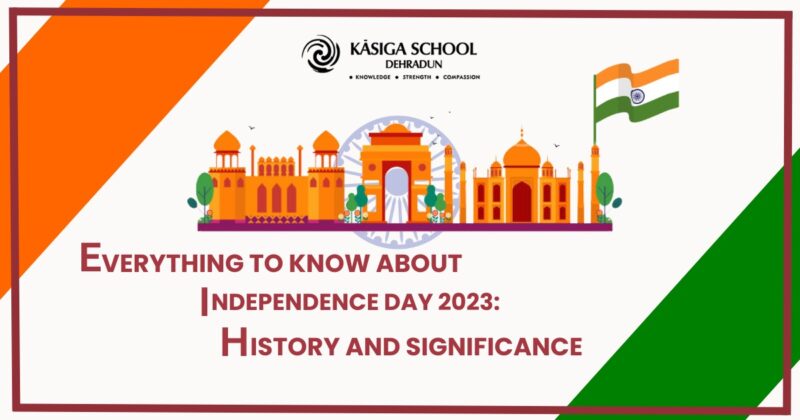Independence Day 2023 is almost approaching and as the country prepares to celebrate its 77th Independence Day India of freedom, the air is thick with pride and enthusiasm. Every Indian heart swells with excitement on this historic occasion as we remember our predecessors’ sacrifices and the indomitable spirit that led to the advent of a new era. So join us as we dig into the details of Independence Day 2023: Date, History, Significance and Celebration!
The History of Independence Day
The history of India’s Independence Day is closely linked to its battle for independence from British colonial rule. Here’s a quick rundown of the major events leading up to India’s independence:
British Colonial Rule: India was under British administration for over two centuries, beginning in the mid-18th century. The British East India Company began by trading and steadily increased its influence over Indian regions.
Indian Independence Movement: India saw the growth of a nationalist movement demanding independence from British domination as the nineteenth century advanced. Many leaders such as Mahatma Gandhi, Subhash Chandra Bose, Bhagat Singh and others were instrumental in rousing the populace against British rule.
Non-Cooperation Movement: In 1920, Mahatma Gandhi began the Non-Cooperation Movement, asking Indians to boycott British institutions, commodities and services. This was an important step towards India’s freedom.
The Civil Disobedience Movement: Gandhi’s Civil Disobedience Movement which began in 1930, heightened the conflict. Indians took part in civil disobedience such as the legendary Salt March in 1930 in which Gandhi led a 240-mile march to protest the British salt tariff.
Quit India Movement: During World War II, the Quit India Movement was established, calling for an immediate end to British rule. The nation was shaken by mass protests and civil disobedience movements.
Independence and Partition: The pressure from the Indian independence movement, along with the British power decline during World War II, led to India’s independence. India won independence from British control on August 15, 1947. The day also recognized India’s partition which resulted in the formation of Pakistan as a distinct nation.
Since then, India has celebrated Independence Day on August 15th every year, honoring the sacrifices made by innumerable liberation warriors and remembering the long road to independence. It is a day of national pride, contemplation of the past and recommitment to sustaining democratic, diverse and united principles.
The Theme for Independence Day 2023
The theme for Independence Day 2023 is “Nation First, Always First” which coincides with the “Azadi ka Amrit Mahotsav” celebrations. Under this campaign, the government has organized a variety of initiatives to recognize the different cultures that enrich our country.
The 77th Independence Day in India will be a celebration of the ethos of putting the nation first and cherishing the ideals that unite us as one united country. The events and activities planned for this occasion will capture the essence of our liberation fight as well as our ongoing commitment to building a successful and harmonious India.
How is Independence Day Celebrated Across India?
In India, the 15th of August is commemorated with tremendous zeal and passion throughout the country. The day is observed with a variety of patriotic activities and ceremonies that bring people from all walks of life together. Here are some of the most prevalent ways in which India celebrates Independence Day.
Flag Hoisting: The day begins with the Prime Minister hoisting the national flag at the Red Fort in New Delhi. This is followed by flag-hoisting ceremonies around the country in schools, universities, government offices and residential complexes. People assemble to see the flag be unfurled and to proudly sing the national anthem.
Cultural Activities: Cultural activities are organized by schools, universities and localities with participants dressed in themed Independence Day attire. These often include speeches, patriotic songs, skits and dance performances that honor the spirit of freedom and togetherness.
Parades and Processions: Many different cities and towns hold parades and processions to emphasize the importance of Independence Day as well as India’s rich culture and traditions. Armed troops, students and other organizations are frequently represented in these marches.
Kite Flying: Kite flying is a common Independence Day tradition. People of different ages fly multicolored kites with the tricolor motif which signifies the occasion’s freedom and joy.
Sweets Distribution: Sweets, particularly the traditional Indian sweet “Jalebi” are presented as a symbol of joy and goodwill among friends, family and neighbors.
Screenings of Patriotic Films: Many television stations broadcast patriotic films and documentaries depicting the difficulties and sacrifices made during the liberation campaign.
Exhibitions and Special Events: Special events and exhibitions relating to India’s independence fight featuring historical relics and documents are frequently held in museums, galleries and public venues.
Social Service Activities: On Independence Day, some individuals participate in social service activities such as arranging blood donation camps, tree planting campaigns and assisting needy areas.
Tri-Color Decorations: Streets, buildings and public areas are decorated and adorned in the colors of the Indian flag – saffron, white and green.
Online Celebrations: With the emergence of modern media, Independence Day is also commemorated online as individuals show their patriotism through postings, messaging and sharing inspiring stories of liberation heroes. Independence Day 2023 is a time for reflection, reminiscence and celebration, uniting India’s diverse people in a shared sense of pride in their country’s hard-won freedom.

